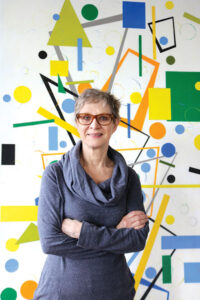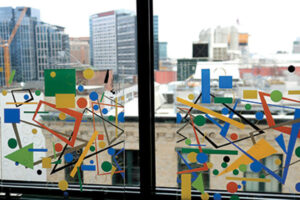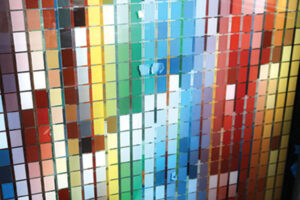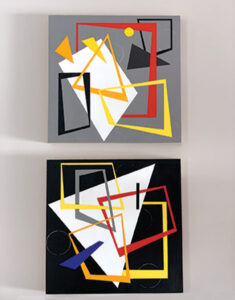By Jane Keller Gordon, Assistant Editor

Boston – Geometric forms embedded in glass — balanced in position and color — will adorn the outside elevator tower of the new Ball Square MBTA Station in Somerville, expected to be completed in 2020. This is the work of Christine Vaillancourt, who usually paints on canvas, paper, and sometimes wood.
“I am excited to have been selected along with six other artists as part of the Green Line Extension Integrated Art Program for seven new stations,” she said. “This is my first large-scale public art project.”
Vaillancourt, a former art teacher, currently creates her art in a 2,300 square foot studio/living space in The Artist Building Cooperative in Fort Point, located near Boston’s Seaport District. She and her husband Frank Gilbane, a web technology analyst, have lived there since the coop was formed in 1995.

“I love it here. From our windows we can see cranes and rooftops of buildings and their mechanicals, which look like abstracted sculptural forms. These urban and industrial images influence my work,” said Vaillancourt.
For the MBTA project, Vaillancourt’s first tasked herself with selecting a color palette by photographing the shingled houses near the future Somerville station. With greens, blues, yellows, orange, gray and black, she created three 90” x 45” paintings, which will be the basis of the elevator’s design.
Over several years, Vaillancourt worked closely with General Glass International in New Jersey to manufacture these paintings in glass. GGI’s room-size 720 DPI printer digitally jets colored ceramic frit onto the surface of the glass. The frit is then baked into the glass during the tempering process.
“Matching the colors with the glass samples has been a long process, but we finally got it,” Vaillancourt commented.
Two 3’ x 4’ glass charts with the Pantone colors still lean up against a wall in her studio.

It seems that Vaillancourt was destined to be an artist. Initially raised in a Detroit suburb, her grandfather, a graduate of Pratt Institute, was hired by Henry Ford as head designer for the “car of the future.” Her father and uncle designed automobiles at General Motors, and later, her father designed airplanes at Stinson Aircraft. Her aunt was an artist.
In her artist statement, Vaillancourt wrote, “The Modernist home I grew up in was filled with objects and materials that had a major impact on the direction of my art — from the patterns of our bold geometric drapes, translucent patterned Formica countertops, bulbous lamp stands, stylized wallpaper, and linoleum square-tiled floors — to Russell Wright Pottery.”
When the family moved to North Carolina when Vaillancourt was 10 her father became a contractor.
“I was hands-on with my father. I helped him build a houseboat and a swimming pool in our backyard,” said Vaillancourt.
She graduated from the University of North Carolina in Chapel Hill with a degree in art education, and a minor in painting. Soon after, Vaillancourt’s parents moved to Rhode Island, and she followed.
While teaching art in Middletown, Rhode Island for 14 years, Vaillancourt remodeled houses and pursued her art. Eventually, she earned a master’s in art education with a minor in jewelry and metalsmithing design from the Rhode Island School of Design.
Looking for a change, Vaillancourt took a sabbatical from her teaching job, and took courses at the Massachusetts College of Art. She has not left Boston since.
For years, Vaillancourt reverse commuted to Newton where she taught art in the public schools. She retired five years ago, but has not retired from creating art.
“I used to tell my students that I taught full time and I painted full time,” she said. .
“It’s taken me a while to find my true style. The modernist art movements between the two world wars have influenced me most… the Bauhaus, geometric Art Deco, and Concrete Art… My previous work was more orthogonal geometry with repetitive patterns, but now I incorporate more open space with more active forms, more movement,” she said.

Some of Vaillancourt’s pieces appear to be encaustic. She has developed a system using acrylics and gel mediums to create a waxy looking surface. By doing this in layers, she adds depth to her pieces.
Vaillancourt’s work can be found in corporate and private collections here and in Canada. One of her pieces hangs in the Route 9 entrance of Bloomingdale’s in Chestnut Hill. She in represented by galleries in Boston, San Francisco, Toronto, and Houston.
For more information, visit www.christinevaillancourtstudio.com.
Photos/Jane Keller Gordon












